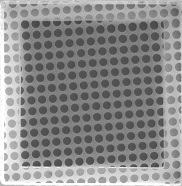
Quantifoil® is a holey carbon film with a thickness of about 12 nm, that is applied on a standard copper or gold electron microscopy grid and provides an ideal support for biological samples in cryo-EM techniques[1-8].
The supporting mesh (copper or gold) is available with distinct numbers. Higher mesh numbers (400) indicate closely spaced bars and provide higher stability, whereas lower numbers (200) provide larger free faces.
The Quantifoil® carbon film has circular holes of defined size and interspace, e.g. R 2/1 (pictured) has holes of 2 µm diameter with an interspace of 1 µm in both dimensions. Higher magnifications usually require smaller holes and vice versa.
You have the following options to choose from:
Quantifoil® film
[1] Lee et al. (2019) Cryo-EM Structures of the Hsp104 Protein Disaggregase Captured in the ATP Conformation. Cell Reports 26:29.
[2] Azubel et al. (2019) FGF21 trafficking in intact human cells revealed by cryo-electron tomography with gold nanoparticles. eLife DOI:10.7554/eLife.43146.
[3] Zhao et al. (2018) Structure and mechanogating mechanism of the Piezo1 channel. Nature 554:487.
[4] Wijnands et al. (2018) Controlling protein activity by dynamic recruitmenton a supramolecular polymer platform. Nat. Commun. 9:65.
[5] Ke et al. (2018) Promotion of virus assembly and organization by the measles virus matrix protein. Nat. Commun. 9:1736.
[6] Zhang et al. (2018) Molecular structure of the ATP-bound, phosphorylated human CFTR. PNAS 115:12757.
[7] Park et al. (2017) Structure of a CLC chloride ion channel by cryo-electron microscopy. Nature 541:500.
[8] Ekiert et al. (2017) Architectures of Lipid Transport Systems for the Bacterial Outer Membrane. Cell 169:273.